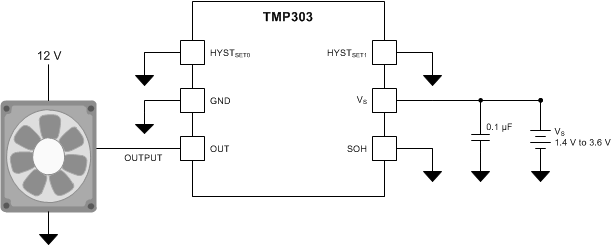SBOS486I July 2009 – December 2018 TMP303
PRODUCTION DATA.
- 1 Features
- 2 Applications
- 3 Description
- 4 Revision History
- 5 Device Options
- 6 Pin Configuration and Functions
- 7 Specifications
- 8 Detailed Description
- 9 Application and Implementation
- 10Power Supply Recommendations
- 11Layout
- 12Device and Documentation Support
- 13Mechanical, Packaging, and Orderable Information
Package Options
Mechanical Data (Package|Pins)
- DRL|6
Thermal pad, mechanical data (Package|Pins)
Orderable Information
9.2.3 Simple Fan Controller
The circuit in Figure 17 senses system temperature and turns a cooling fan on when the sensor's temperature exceeds a preselected value. The TMP303 device can be used directly to control the fan. The OUT pin is active high, and it can be used directly to drive the DC fan. When temperature is within the temperature limits of the system, the fan turns off, and when the temperature exceeds the trip-point, the fan turns on. In this example, the TMP303A device is used and is configured with a 1°C hysteresis window (HYSTSET0 = HYSTSET1 = GND). The TMP303A high trip-point is 60°C. When this trip-point temperature is exceeded, the output (OUT) changes state from low to high. The output does not return to its low state until the temperature decreases below
(TH – hysteresis) = 59°C.
 Figure 17. Simple Fan Controller
Figure 17. Simple Fan Controller